Whether you own commercial property or a residential driveway, a well-maintained asphalt surface can increase your curb appeal and make a positive impression on visitors. Parking Lot Resurfacing restores damaged blacktop to its previous shine and strength, while being less expensive than replacement.

However, it is important to know the difference between resurfacing and repaving so you can choose the best repair service for your business.
Getting cracks repaired is one of the most effective ways to extend your asphalt parking lot’s lifespan and keep your business or property looking great. If left untreated, cracks can widen and create tripping and slipping hazards for people walking on the blacktop or driving on it. Keeping up with regular pavement maintenance also helps you avoid expensive repair bills that can result from neglected damage.
While most cracks in a parking lot can be repaired using asphalt patching, resurfacing is required if the cracks are large or if they have been left unchecked for an extended period of time. Resurfacing will return your parking lot to its original condition and improve curb appeal. To prepare for resurfacing, the surface must be cleaned, and structures like wheelchair ramps and concrete speed bumps must be removed or adjusted as needed. Structures for utility companies, such as wires or pipes, will also need to be removed or adjusted if necessary.
Simple cracking caused by cycling seasons and heavy traffic can quickly grow into potholes, crevices or sunken-in areas that are difficult to drive through. Left untreated, these issues can increase your maintenance costs and create safety hazards for both pedestrians and drivers.
Fatigue cracks are another type of crack that can be challenging to repair. They typically form due to long-term wear and tear, a poor asphalt installation or a subsurface drainage system that isn’t well-designed or maintained. This type of crack is often found near driveway entrances or in the corners of your parking lot.
Asphalt crack filler works to seal these small holes and extend the lifespan of your asphalt surface, making it a good option for parking lots that require regular maintenance. It also prevents moisture from penetrating the surface and creating further damage.
Potholes
Asphalt parking lots are exposed to the elements, so they can get damaged over time. The weather can wear away at asphalt in different ways, depending on the region’s climate and how often it rains. The high volume of traffic that parks endure daily can also cause distortion in the surface and lead to uneven services.
A common issue that can occur is potholes. These are big, deep holes that form when water seeps in through cracks and erodes the asphalt. It’s important to be vigilant about noticing signs of pothole damage and address them right away because they can quickly become a safety hazard for drivers. They can damage cars and create unsafe conditions for pedestrians, especially those using mobility aids like wheelchairs.
In order to repair potholes, you must first clean the area and fill it with a hot asphalt mix. Then, compact the material and finish it off with a smooth ride to prevent vehicles from hitting the pothole again in the future. The surface should be closed for 24 hours to allow it to properly harden.
While the above tips will help with some of the more minor issues, you’ll still need to consider resurfacing or replacing your parking lot in order to fix serious problems and improve its curb appeal. A professional commercial paving contractor can help you decide which option is best for your parking lot.
Infrared asphalt repair is a long-lasting solution for potholes. Infrared technology heats the current asphalt to soften it and then blends in new asphalt to create a smooth, cohesive surface. This method eliminates unwanted joints, preventing moisture from infiltrating the foundation and causing more damage.
Uneven Surfaces
A well-maintained parking lot is a clear statement of a business’s commitment to safety and convenience. A well-surfaced parking lot provides comfort and ease for visitors, making it more likely that they’ll linger longer and return regularly. This heightened satisfaction contributes to a positive customer experience that is amplified by word-of-mouth marketing and serves as a hallmark of the brand.
Over time, asphalt surfaces are subject to a variety of elements that can create unevenness. Uneven surfaces aren’t only unappealing, but they can lead to tripping hazards for pedestrians and vehicles. Asphalt cracks that are left unattended can grow in length and width, causing tripping accidents. Moreover, as these cracks expand, they can cause the surface of your parking lot to become loose and crumble, exposing underlying aggregates.
Another sign of an uneven parking lot is the presence of low spots in the asphalt. These are typically caused by a faulty drainage system that results in water pools and puddles in various areas of the lot. Aside from their unappealing appearance, these puddles pose safety risks for pedestrians and can damage a vehicle’s undercarriage.
Additionally, the signs of a parking lot that need resurfacing can include faded markings and fading paint lines. Due to constant exposure to sunlight, weather, and traffic, these markings can lose their brightness. This can be a problem for drivers who may have trouble finding their vehicles in the dark. It’s important to have these markings redrawn and repainted during the resurfacing process to ensure that they are visible and clearly delineated.
Uneven Services
The average lifespan of a parking lot is 7-10 years, but routine maintenance can help you get the most out of your asphalt. Keeping your lot in good shape can help you avoid the costs of replacement and keep your customers happy. A professional paving company can evaluate your parking lot and recommend the right services for its condition. From resealing to full repaving, a parking lot resurfacing project can restore your blacktop to a new look.
Cracks and potholes are obvious indicators that your parking lot needs repair. But resurfacing can help with other issues, too. Uneven surfaces indicate pressure from vehicles that can warp the asphalt, and resurfacing can help prevent this problem.
Parking lots can also become uneven due to drainage problems. When water pools in the asphalt, it causes damage to the surface and can lead to tripping accidents and liability issues for your customers.
Uneven pavement can be caused by a number of factors, including weather, environmental conditions, and traffic patterns. Depending on where your parking lot is located, temperature changes can cause the asphalt to expand and contract, resulting in cracking and other imperfections.
Other problems that call for resurfacing include faded parking stripes and lines, which can make it difficult for customers to park safely or find their vehicle. Resurfacing your parking lot can include redrawing these essential lines so they are bright and visible to visitors. This can also help prevent confusion and accidents. In addition, stains in your parking lot are another indication that it’s time for resurfacing. These stains are often caused by industrial solvents or vehicle fluids, and can seep into the asphalt and erode its binding agents.
Uneven Curb Appeal
A commercial property’s parking lot has a significant impact on the property, from creating a first impression to influencing traffic patterns. As such, it’s essential that it is well-maintained. However, parking lots wear out over time due to heavy use, chemical exposure, and weather. When your commercial parking lot begins to show signs of wear, such as small cracks or faded colors, it can give a bad impression to customers and turn them away from your business.
If your asphalt is damaged, you should consider parking lot resurfacing. It’s a great way to refresh the look of your parking lot and improve curb appeal without the cost of replacing the entire surface. Parking lot resurfacing involves placing a layer of new asphalt over the existing surface, which gives it a smooth, jet black appearance that looks brand-new. It also helps to extend the lifespan of the parking lot, saving you money in the long run.
Parking lots with cracks, potholes, and fading colors can leave a negative impression on visitors, even before they enter the building. Keeping your parking lot in good condition through services like resurfacing can create a positive first impression and make your business appear professional and legitimate to customers.
If you’re looking for a parking lot repair company to help you with your commercial property, contact Interstate Paving today! We offer a variety of services to keep your parking lot in top shape, including sealcoating, patching, and crack filling. Our team of professionals will work with you to choose the right maintenance options for your property to ensure it lasts a long time. Call us to schedule your service or request a quote online!
